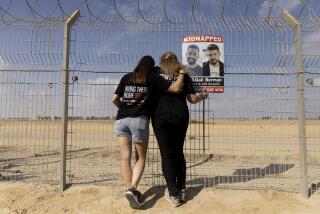Negotiating the Mideast
American presidents have never had an easy time in the Middle East. For 60 years, they have been trying to make peace, or just prevent recurrent wars, and the record of success is thin while the death toll from the violence is disturbingly high.
The current war against Hamas in Gaza, coming after eight years of diplomatic paralysis by the Bush administration, illustrates the state of diplomatic gridlock today and suggests that a Promethean task awaits President-elect Barack Obama if he is to stop the rocket salvos coming out of Gaza, enforce a cease-fire, ensure an Israeli withdrawal, reconcile the Palestinian community, find partners among the moderate Arabs for a broader peace and construct a credible framework for dealing with Iran.
And that’s just in the first 100 days.
A close inspection of presidential archives, oral histories and other records shows that each president since Harry Truman has tried to make a fresh start in the region, often trying to distinguish himself from his predecessor, and this very human trait has contributed to the absence of consistency from one president to the next.
Here are the key peacemaking efforts over the years, as well as some of the lesser-known initiatives that have been declassified.
Dams for peace
In the mid-1950s, President Eisenhower wanted to build hydroelectric dams to turn the barren hills of the West Bank and Jordan Valley into an agricultural mecca that might coax Palestinian refugees, displaced by war, out of their camps and onto new farms. He also wanted Israel to give up a sliver of land that would connect Egypt and Jordan via a highway overpass. Both sides rejected the ideas.
No-nukes JFK
In December 1960, President-elect Kennedy learned that Israel was secretly building a nuclear reactor complex that eventually would be able to produce atomic weapons. He waged an unsuccessful behind-the-scenes campaign until his death in 1963 to persuade David Ben-Gurion, the Israeli leader, to give it up.
Rogers plan
In December 1969, President Nixon’s secretary of State, William P. Rogers, proposed the first comprehensive peace plan in the wake of the Six-Day War of 1967, calling for the return of Arab lands and secure borders for Israel. The plan said minor changes in borders might be possible, but they could “not reflect the weight of conquest.” Nixon’s support for the plan was open to question. Israeli Prime Minister Golda Meir said she saw no chance for peace while Egypt was ruled by the Arab nationalist, Gamal Abdel Nasser.
Brezhnev’s alarm
In June 1973, Soviet leader Leonid I. Brezhnev literally got President Nixon out of bed during their summit talks in San Clemente. War was coming, again, in the Middle East, he warned. He pressed Nixon to agree on some basic principles for peace -- including security for Israel -- that could form the basis for negotiations that might avert war. Nixon, weakened by Watergate, demurred. The October War followed four months later, and Nixon later acknowledged his failure in a private conversation with Henry Kissinger.
Camp David
President Carter entered office in 1977 determined to press for comprehensive Middle East peace after Kissinger’s shuttle diplomacy had stalled in the wake of the 1973 war. Then, Egyptian President Anwar Sadat staged his dramatic visit to Jerusalem in November 1977, infuriating other Arab leaders. Carter, at wit’s end on how to proceed, invited Sadat and Prime Minister Menachem Begin to Camp David in September 1978 and hammered out the framework for a peace treaty between Israel and its largest enemy. The Palestinian question was deferred to a separate negotiating track that went nowhere.
The Reagan plan
Two months after Israel invaded Lebanon in 1982, President Reagan called for Israel to withdraw from the West Bank and Gaza and to establish Palestinian self-government in coordination with Jordan.
Begin, whose army was in the midst of trying to destroy the Palestine Liberation Organization in Lebanon, saw Reagan’s act as an attempt to undermine Israeli war aims. Moreover, Begin had vowed never to give up the West Bank because he considered it part of historic Israel.
Madrid conference
Following the Persian Gulf War defeat of Iraqi leader Saddam Hussein’s forces in Kuwait, President George H.W. Bush convened the Madrid peace conference in the fall of 1991, affording a rare opportunity for an Israeli prime minister, in this case, Yitzhak Shamir, to sit with Arab leaders and debate their long-standing grievances. Little came from the effort, but just the fact that the leaders met and committed themselves to peace encouraged a new momentum in Arab and Israeli societies for negotiation.
Oslo Accords
The first major breakthrough after Camp David occurred when Palestinian and Israeli negotiators, without the knowledge of the U.S., met for months in secret venues in Norway and emerged with a “declaration of principles” to create Palestinian self-rule, to be followed by “final status” negotiations over five years that both sides expected to result in statehood under PLO leader Yasser Arafat.
Arafat and Israeli Prime Minister Yitzhak Rabin shook hands after the Oslo Accords were signed on the White House lawn on Sept. 13, 1993. Although a full peace between Israel and Jordan followed, outbreaks of terrorism and disputes about Hebron and further land concessions were still underway when, in July 2000, the parties flew to Camp David for a final, unsuccessful effort to reach peace.
Clinton parameters
President Clinton was unable to make both sides agree on them in 2000, but these parameters have remained on the table as what many politicians and analysts believe may be the most workable framework for peace. A Palestinian state would arise on 99% of the West Bank and Gaza; Jerusalem would serve as the capital for both states, with Arab neighborhoods making up the Palestinian capital and Jewish neighborhoods constituting the Israeli capital. Special arrangements would be made to share the Temple Mount at the center of the Old City, and the Palestinian right of return would be diverted to the Palestinian state with some humanitarian exceptions.
Patrick Tyler, a former foreign correspondent for the New York Times and the Washington Post, is the author of “A World of Trouble: The White House and the Middle East -- from the Cold War to the War on Terror” (Farrar, Straus & Giroux).
More to Read
Sign up for Essential California
The most important California stories and recommendations in your inbox every morning.
You may occasionally receive promotional content from the Los Angeles Times.










